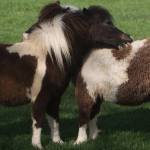Allergic Reactions in Horses

Signs of allergy occur when an insect bite, chemical preparation, or an inhaled substance such as dust causes the horse’s immune system to react to the irritant. Horses show the most obvious allergy signs as changes in the skin, eyes, or nostrils.
Hives are soft swellings just under the skin. They are sometimes itchy but not painful, and may be small or very large. Hives that are few in number and limited to a small body area are most likely caused by a localized sensitivity to a liniment, fly spray, or other externally applied product. Hives that are spread over the horse’s entire body usually indicate sensitivity to something that affected the whole horse. Though they are sometimes called “feed bumps” or “protein bumps,” hives are rarely caused by feed ingredients and may be a reaction to an injection or some other irritant.
Intense itching, another common skin reaction, can be caused by an oversensitivity to insect bites. Owners may find raw, oozing patches where the horse has rubbed off hair and skin in an attempt to scratch the itchy spots that are commonly found on the face, chest, midline of the belly, or base of the tail.
Conducting an allergy investigation is a time-consuming endeavor, so a veterinarian may first rule out more common dermatological problems including external parasites (mites or lice, for instance), fungal infections such as dermatophytosis, bacterial folliculitis (inflammation of the hair follicle), and atrophy, an inherited predisposition to environmental allergen sensitivity. Horses are known to exhibit contact dermatitis following exposure to a variety of agents, including organophosphate pesticides, heavy metals, aniline dyes found in tack, bedding, topical medications, soaps, shampoos, blankets, neatsfoot oil, and wool.
Inhaled irritants such as dust, mold, and pollen can trigger allergic reactions in sensitive horses. Signs are coughing, exercise intolerance, and sometimes a thin, clear nasal discharge. If the cause is allergy, there is no elevation in body temperature. The reaction may be to airborne particles in a barn, in which case the horse gets better if he is turned out to pasture, or by molds and pollens in pasture grass, in which case the horse improves if he is kept in a stall.
Horses may develop eye irritation and increased tear production because of airborne particles of mold, dust, and pollen. Horses may rub or toss their heads to try to relieve itchy, irritated eyes and nostrils.
Severe allergic reactions can make horses so uncomfortable and distracted that they are unable to train or perform. Finding the cause of an allergic reaction and working out a treatment may be difficult. Owners can ask a veterinarian for help in alleviating an allergic horse’s signs and determining a plan to avoid the irritant that has caused the problem.
Related reading:








